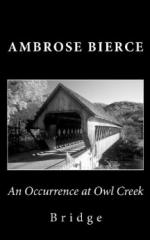|
This section contains 529 words (approx. 2 pages at 300 words per page) |

|
SOURCE: Conlogue, William. “Bierce's ‘An Occurrence at Owl Creek Bridge’.” The Explicator 48, no. 1 (fall 1989): 37-8.
In the following essay, Conlogue finds a connection between Peyton Farquhar and a medieval band of hemp-eating Moslem assassins.
In “An Occurrence at Owl Creek Bridge” Peyton Farquhar grows hemp. These tree-like plants, used in making rope, grow to over 15 feet in height. The narrator of “An Occurrence at Owl Creek Bridge” tells us that Farquhar is a “student of hanging”; he studies rope (12). The American Heritage Dictionary gives as one definition of rope, “death by hanging” (1071). Farquhar's “gyration,” his whirling round and round in the river, mimics the twisting of hemp to make rope (16). The trees Farquhar notices along the river bank have a “definite order in their arrangement,” as if they had been planted (16). Farquhar has entered a paradise where “roseate light” shines and “the music of aeolian harps” plays in...
|
This section contains 529 words (approx. 2 pages at 300 words per page) |

|


